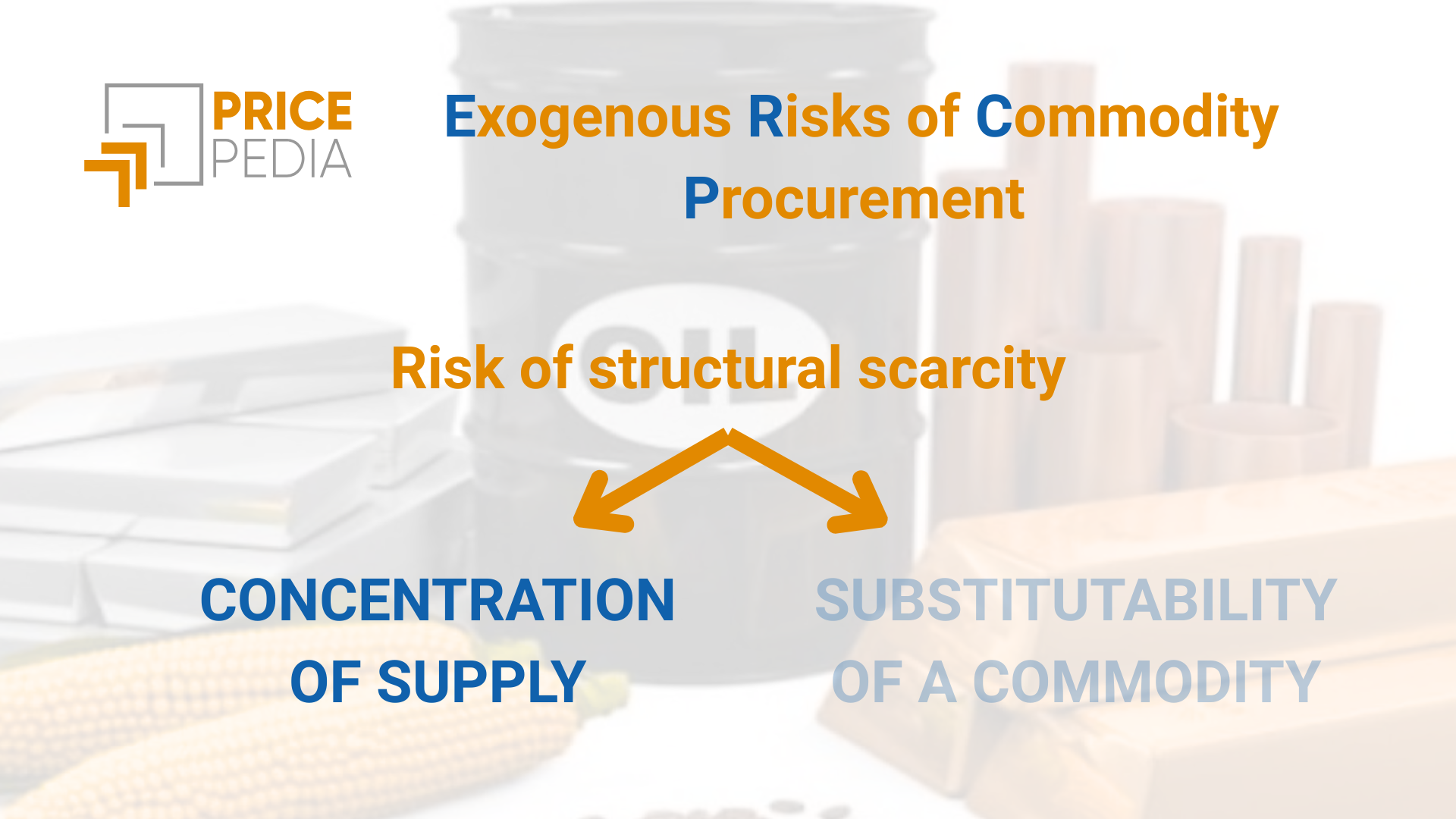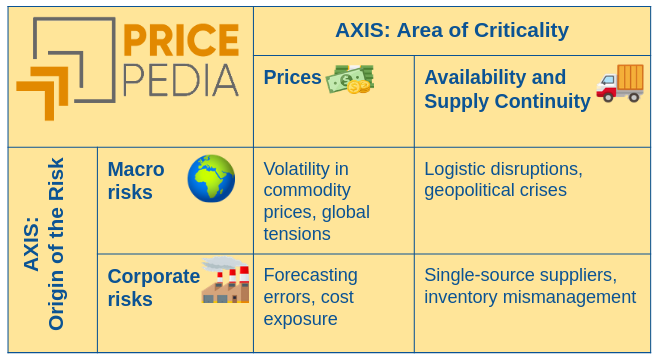Commodity tariffs and prices
Rising trade tensions between the US, China and the EU increase the risk of higher commodity prices
Published by Luigi Bidoia. .
Procurement Import tariffsThe decision of the European Commission to proceed with the application of additional tariffs to the current 10% on imports of electric cars from China represents a further step towards increased trade tension between the world's major economic areas.
The European Commission has always used the tariff tool within the rules established by the World Trade Organization (WTO). These rules, however, are far from stringent, leaving ample room for action by individual countries. It is therefore possible that we will see an increase in tariffs by the EU in the near future, especially on imports from China.
Since China is one of the main countries from which the EU imports raw materials,
the risk of commodity price increases linked to possible tariff hikes is not negligible. It may therefore be useful to briefly review the different types of tariff measures that the European Commission can use and how these have been applied so far in the context of raw material imports into the EU.
Different Types of Tariff Measures
In addition to the normal tariff measures, which follow the WTO Most-Favoured-Nation (MFN) principle, and the reduced tariffs under bilateral free trade agreements (Free Trade Agreements - Preferential Tariffs), the EU has developed many other "special" tariff measures over time. Among these, the measures that can lead to an increase in the prices of imported raw materials are numerous and can be grouped into the following categories:
- Anti-dumping and/or countervailing duties: These are specific measures adopted to protect European industry from unfair trade practices, such as dumping (selling products at prices below production costs) and unfair subsidies by third countries;
- Additional duties: These can be imposed in addition to normal customs duties. Often they are safeguard measures imposed to protect a national industry from a sudden and significant increase in imports that threatens to cause serious damage. They are temporary and intended to give local industries time to adjust to new market conditions;
- Tariff quotas: These measures set quantitative limits for the importation of specific goods at reduced or zero tariffs. Tariff quotas can be preferential, based on specific trade agreements, or non-preferential, applied non-discriminatorily to all imports;
- Import controls and restrictions: These are measures adopted to control and limit the importation of certain products for reasons of safety, environment, health, compliance with international regulations, or to meet European standards regarding net weight, supplementary units, net mass, and other physical or legal characteristics;
- Carbon Border Adjustment Mechanism (CBAM): This mechanism, introduced in May 2023, aims to equalize imported goods with goods produced in the EU in terms of charges due to CO2 emissions.
These tariff measures are crucial tools for EU trade policy, used to ensure fair competition and to protect local industries from unfair trade practices or imports that can cause significant economic harm.
Tariff Measures in Place on Commodity Imports
To evaluate what the EU's tariff policy has been and how it may develop in the coming years, it may be useful to map out the general EU tariffs applied to various imported commodities and the special measures currently in place.
General Tariffs
General tariffs are those applied to imports of raw materials (commodities) and, more generally, to goods according to the WTO Most-Favoured-Nation principle. This principle states that a WTO member country must extend any tariff reduction granted to another member country to all other WTO members, except where such reduction is part of bilateral or regional free trade agreements (preferential tariffs[1]).
The table below shows, for the various price families of PricePedia, the number of commodities that fall into the different tariff brackets indicated in the columns. Since not all tariffs are expressed as a percentage of the import value (ad valorem tariffs), but some are specific (i.e., calculated as a fixed amount per unit of imported goods, regardless of the value of the goods), the table includes a column that counts commodities with such tariffs.
Number of Commodities by Tariff Level
| Commodity Family | None | <2% | 2%-5% | 5%-9% | Specific | Total |
|---|---|---|---|---|---|---|
| Energy | 11 | 1 | 20 | 3 | 0 | 35 |
| Ferrous | 88 | 3 | 7 | 6 | 0 | 104 |
| Non-Ferrous | 25 | 0 | 25 | 16 | 0 | 66 |
| Organic Chemicals | 12 | 0 | 11 | 72 | 2 | 97 |
| Plastics and Elastomers | 13 | 0 | 0 | 40 | 0 | 53 |
| Inorganic Chemicals | 11 | 2 | 14 | 76 | 0 | 103 |
| Specialty Chemicals | 1 | 0 | 7 | 29 | 0 | 37 |
| Food | 6 | 2 | 5 | 11 | 31 | 56 |
| Textile Fibers | 13 | 2 | 19 | 6 | 0 | 40 |
| Wood and Paper | 54 | 0 | 2 | 8 | 0 | 65 |
| Mechanical Components | 0 | 0 | 12 | 7 | 0 | 19 |
| Electrical Components | 1 | 0 | 13 | 0 | 0 | 14 |
| Electronic Components | 35 | 0 | 0 | 0 | 0 | 35 |
From the analysis presented in the table, it is evident that a very high proportion (almost 40%) of imported commodities are exempt from import duties. Among these, the families with the highest percentage of products with zero tariffs are Ferrous, Wood and Paper, and especially Electronic Components. The zero tariffs on imports of paper and wood are justified by the scarcity of wood raw materials in Europe. The zero tariffs on electronic components reflect the EU's high dependence on Asia for these intermediate goods. The zero tariffs on almost all imports of ferrous commodities seem less justified. This anomaly is compensated by a high number of special measures in force on products in this family.
On the other hand, families within the chemical industry have relatively high tariff rates, indicating the EU's special attention to safeguarding this important industrial sector, even through general tariffs.
Special Measures
The EU's special tariff measures (described above) currently in force on imports of commodities into the EU are numerous and concern many countries. Among these, a high number of measures relate to imports from China.
In the table below, for the different product families of the PricePedia classification, the number of products affected by the various types of measures currently in force on imports from China is shown.
Number of Commodities by Measure in Force on Imports from China
| Commodity Family | Anti-dumping | Anti-dumping | Controls | None | Total |
|---|---|---|---|---|---|
| and quotas | and quotas | measure | |||
| Energy | 0 | 0 | 0 | 35 | 35 |
| Ferrous | 52 | 9 | 10 | 33 | 104 |
| Non-Ferrous | 5 | 0 | 0 | 59 | 64 |
| Organic Chemicals | 4 | 0 | 0 | 93 | 97 |
| Plastics and Elastomers | 1 | 0 | 0 | 52 | 53 |
| Inorganic Chemicals | 3 | 0 | 0 | 100 | 103 |
| Specialty Chemicals | 1 | 0 | 0 | 36 | 37 |
| Food | 0 | 0 | 1 | 55 | 56 |
| Textile Fibers | 1 | 0 | 0 | 39 | 40 |
| Wood and Paper | 0 | 0 | 0 | 65 | 65 |
| Mechanical Components | 7 | 0 | 0 | 12 | 19 |
| Electrical Components | 1 | 0 | 0 | 13 | 14 |
| Electronic Components | 0 | 0 | 0 | 35 | 35 |
Out of 722 products analyzed, 95 commodities are subject to special EU measures on imports from China. Most of these measures involve anti-dumping and countervailing duties applied almost entirely to commodities in the ferrous family. The affected products range from magnetic sheets to steel coils, both hot-rolled and cold-rolled, both alloyed and ferritic and austenitic, from wire rod to certain types of welded tubes of non-alloy steel. Among the commodities in other families are products such as melamine, titanium dioxide, aluminum sheets, and polyethylene terephthalate (PET).
Conclusions
Since 2018, with the outbreak of the trade war between the United States and China, the orientation of the world's major economies in terms of tariff policies has changed. The shift has been from a global vision of the world economy, where all measures aimed at supporting international trade had positive repercussions on all countries, to a vision where international trade has become an area of confrontation between "The West and the Rest." In this new context, tariff policy has become a crucial tool to support national businesses and protect them from competition, especially unfair competition, from foreign companies.
Customs tariffs are now used strategically to combat unfair trade practices such as dumping and distorting state subsidies. The European Union, following this global trend, has adopted anti-dumping and countervailing measures on various commodities, particularly those in the ferrous family.
It is likely that in the near future, there will be many cases of increases in import tariffs by the EU, especially through the use of anti-dumping and countervailing duties. This trend reflects a growing focus on protecting strategic European industries and promoting fairer competition conditions in the global market. Tariffs may also be increased for other categories of products, replicating what has already been done for many commodities in the ferrous family.
Moreover, the introduction of mechanisms such as the Carbon Border Adjustment Mechanism (CBAM) highlights the EU's intention to integrate environmental considerations into its trade policies, seeking to balance economic protection with sustainability goals. This integrated approach could become a model for other nations.
The effects of the ongoing changes on European commodity prices may not be marginal.
[1] Preferential tariffs are reduced tariffs applied under bilateral or regional Free Trade Agreements (FTA), which do not necessarily have to be extended to all WTO members.


